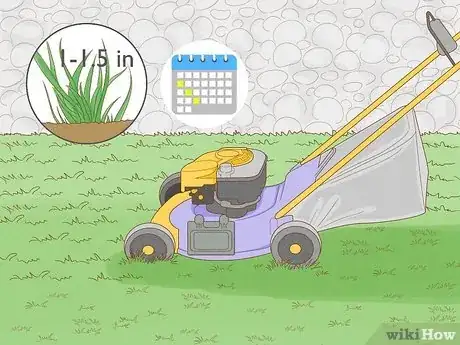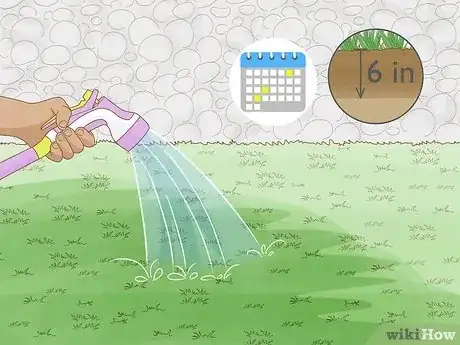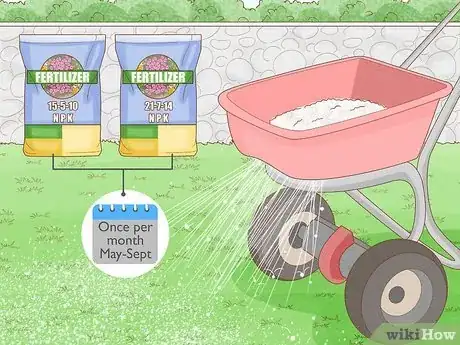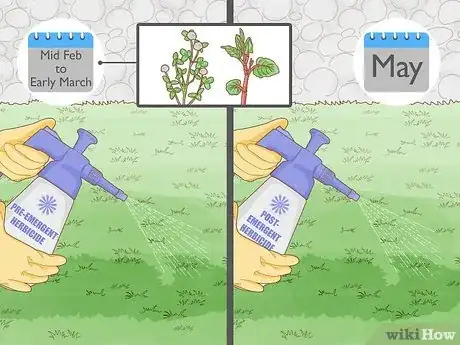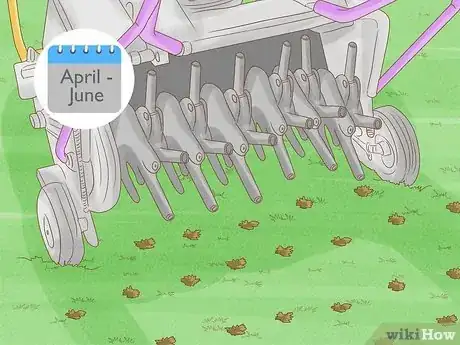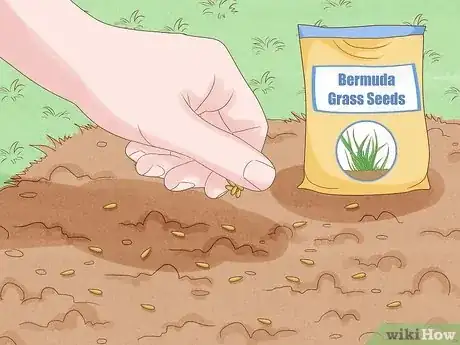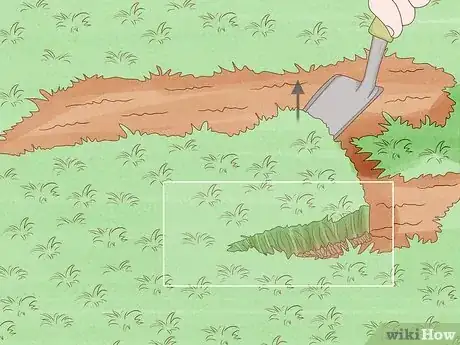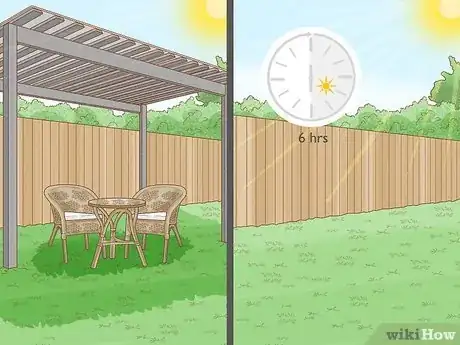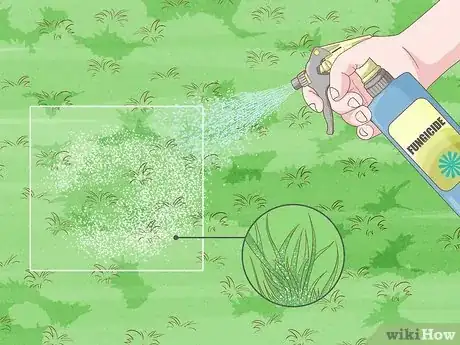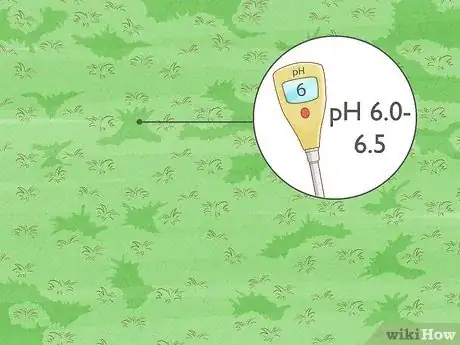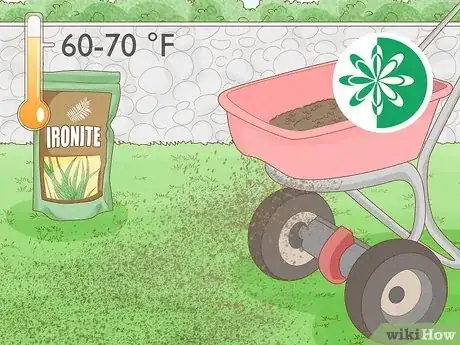This article was written by Jeremy Yamaguchi and by wikiHow staff writer, Kira Jan. Jeremy Yamaguchi is a Lawn Care Specialist and the Founder/CEO of Lawn Love, a digital marketplace for lawn care and gardening services. Jeremy provides instant satellite quotes and can coordinate service from a smartphone or web browser. The company has raised funding from notable investors like Y Combinator, Joe Montana, Alexis Ohanian, Barbara Corcoran and others.
There are 11 references cited in this article, which can be found at the bottom of the page.
This article has been viewed 7,341 times.
Dealing with patchy or thin Bermuda grass? The thick, green lawn of your dreams might be easier to achieve than you think. Making Bermuda grass spread into a luscious lawn comes down to pretty simple factors—proper mowing, watering, and maintenance. We’ll walk you through everything you need to know about fixing nutrient deficiencies in the soil, dealing with soil compaction, and creating the ideal growing conditions for thick Bermuda grass.
This article is based on an interview with our lawn care specialist, Jeremy Yamaguchi, founder of Lawn Love. Check out the full interview here.
Steps
Mow low and mow every 5-7 days.
-
To make Bermuda grass thicker, mow it to 1–1.5 in (2.5–3.8 cm). Cutting the Bermuda grass short will create a denser lawn because the plant will channel its energy into horizontal spread rather than vertical growth. You can use either a rotary or reel mower—either works![1] X Research source Mow roughly once a week to keep your lawn looking thick and healthy.[2] X Research source
- During periods of drought or extreme heat, raise the mowing height to around 2 in (5.1 cm) to reduce plant stress.[3] X Research source
- If your grass is already really long, only remove ⅓ of the plant height at a time. Gradually adjust your mowing height lower and lower every week until you hit the 1–1.5 in (2.5–3.8 cm) range.
Water your lawn every 5-10 days.
-
Bermuda grass does best with deep, infrequent watering. Wet the soil to 6 in (15 cm), and use a soil probe to make sure you’ve watered enough. Then, wait to water again until the grass shows drought stress (which will take 5-10 days, depending on your weather). You'll know you should water again when the leaves turn dull blue and start to fold.[4] X Research source
- To prevent run-off and make sure you’re watering deep enough, you might have to run your sprinklers in 30-minute or 1-hour intervals. Watering in intervals gives the soil time to absorb everything.
- Grass doesn’t grow well with wet roots. If you see muddy puddles of water on your lawn, it’s time to dial back the amount you’re watering.
Apply a nitrogen fertilizer.
-
Add fertilizer about 3 weeks after your Bermuda grass turns green in May. To get the best fertilizer, do a soil test to check what ratio nitrogen, phosphorus, and potassium (NPK) will work for your lawn. If you don’t want to do a soil test, a safe bet is to use a 3-1-2 NPK ratio like a 15-5-10 or 21-7-14 fertilizer.[5] X Research source Apply fertilizer once per month during the May-September growing season, spreading 0.5–1 lb (0.23–0.45 kg) of nitrogen per 1000 sq ft each time.[6] X Research source
- Since applying 0.5 lb (0.23 kg) of fertilizer isn’t the same thing as applying 0.5 lb (0.23 kg) of nitrogen, you’ll need to do a quick conversion.
- To figure out how much fertilizer you need to get 0.5 lb (0.23 kg) pound of nitrogen, divide 50 by the first number on the fertilizer bag.
- For instance, if you’re using a 15-5-10 fertilizer, 50 divided by 15 equals 3.3, so you’d need to distribute 3.3 lb (1.5 kg) of fertilizer to actually get 0.5 lb (0.23 kg) of nitrogen.
- You don’t need to fertilize in the fall or winter because the plants are likely dormant during that season.
Get weeds under control.
-
Weeds will make Bermuda grass lawns look thin and patchy. To get ahead of a weed problem, apply a pre-emergent herbicide in the window between mid-February to early March. Then, in May, apply a post-emergent herbicide to tackle species like white clover and knotweed.[7] X Research source
- Pre-emergent herbicides create a boundary in the soil to prevent weed growth.
- Each product is different, but in general, you should apply a pre-emergent herbicide 2-3 times a year.
Aerate the lawn.
-
Aeration increases airflow to the roots in order to promote growth. Wait until the warmer months, ideally from April to June, then aerate your lawn to give it some room the breathe! Use a core aerator to punch holes in your soil and free up your Bermuda grass roots.[8] X Research source
- You should wait several months to aerate the lawn if you just applied pre-emergent herbicide.
Overseed to fill in bare spots.
-
Overseeding means you’ll add more grass seed without turning the soil. Prep your lawn for overseeding by mowing and bagging the clippings (so the clippings don’t act as a barrier between the seeds and the soil). Aerate and rake the lawn to clear any thatch, debris, or rocks. Then, spread about 16 seeds per 1 in (2.5 cm) with a seed spreader.[9] X Research source
- When you choose seeds to overseed a Bermuda grass lawn, try using annual ryegrass, as an optional strategy to keep your lawn looking green through winter.[10] X Research source
- After you overseed, lightly water 2-3 times a day for 7-10 days before returning to your regular watering schedule.[11] X Research source
Remove thatch during the growing season.
-
Thatch is a layer of decomposed plant material that can prevent growth. It’s fine to have 0.5 in (1.3 cm) of thatch nestled at the bottom of your grass blades, but more than that can inhibit your lawn’s health. To dethatch Bermuda grass, use a vertical mower to pull the organic matter up to the surface.[12] X Research source
- It’s best to remove thatch from March-May before your Bermuda grass enters it’s true growing season.
Reduce shade over your lawn.
-
Bermuda grass has a low tolerance for shade.[13] X Research source In fact, most grass needs at least 6 hours of full sun a day. For your lawn to thrive, consider pruning trees around the perimeter of the turf. Remove any umbrellas or patio furniture that might be blocking out valuable sunlight.
Treat any lawn diseases.
-
Fungus and pest infestations can cause dead spots in your lawn. To remedy the problem, you can apply fungicide once temperatures are between 60–80 °F (16–27 °C). Make sure you spread the fungicide all the way to the roots by watering at least 1⁄8 in (0.32 cm) deep after you’ve applied it.[14] X Research source
- Bermuda grass doesn’t typically suffer from insect infestations because it grows so rapidly, but you can apply insecticide in June to prevent white grubs.[15] X Research source
Adjust your soil pH to 6.0-6.5.
-
Improving soil pH is a long-term strategy to encourage growth. To find your soil pH, do a pH test. Use sulfur to lower pH and use lime to raise pH.[16] X Research source Any time you amend the soil for pH, do another pH test 3 months later to check your lawn’s progress. Just keep in mind, it might take a few years to truly change the pH.
- Apply 5 pounds (2.3 kg) of pelletized sulfur per 1000 square feet of turf, only when the air temp is below 75 °F (24 °C).
- The amount of lime you need to raise pH will vary depending on your soil type. In general, the amount ranges from 25–100 lb (11–45 kg) per 1000 sq ft of turf.[17] X Trustworthy Source Penn State Extension Educational organization dedicated to delivering science-based information to people, businesses, and communities Go to source
- December through February provides a good window to adjust soil pH as you likely won’t be fertilizing during that period.[18] X Research source
Use an iron supplement for greener grass.
-
Iron deficiency can cause yellow, patchy grass—though this is pretty rare. Bermuda grass will naturally go dormant in colder months, but by May, the lawn should start to “green up.” If it doesn’t look green and lush, first double-check that your watering and fertilizing routines are dialed in. Then, you can try adding an iron supplement like Ironite.[19] X Research source
- Only apply iron in the spring when temperatures are between 60–70 °F (16–21 °C).
- Check the instructions on the package to prevent applying too much iron.
You Might Also Like




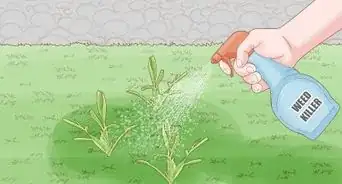



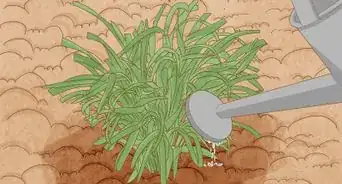

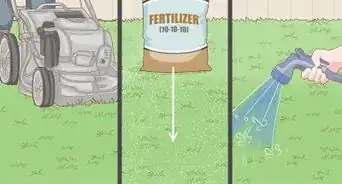
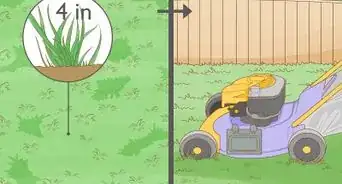


References
- ↑ http://ipm.ucanr.edu/TOOLS/TURF/TURFSPECIES/bermudatips.html
- ↑ https://www.uaex.uada.edu/publications/pdf/FSA-6121.pdf
- ↑ https://hgic.clemson.edu/factsheet/bermudagrass-maintenance-calendar/
- ↑ http://publications.tamu.edu/TURF_LANDSCAPE/PUB_turf_Maintaining%20Bermudagrass%20Lawns.pdf
- ↑ http://publications.tamu.edu/TURF_LANDSCAPE/PUB_turf_Maintaining%20Bermudagrass%20Lawns.pdf
- ↑ https://hgic.clemson.edu/factsheet/bermudagrass-maintenance-calendar/
- ↑ https://content.ces.ncsu.edu/bermudagrass-lawn-maintenance-calendar
- ↑ http://publications.tamu.edu/TURF_LANDSCAPE/PUB_turf_Maintaining%20Bermudagrass%20Lawns.pdf
- ↑ https://www.bobvila.com/articles/how-to-overseed-a-lawn/
- ↑ https://extension.arizona.edu/overseeding-bermudagrass-lawns-annual-ryegrass
- ↑ https://aggie-horticulture.tamu.edu/plantanswers/turf/publications/overseed.html
- ↑ http://publications.tamu.edu/TURF_LANDSCAPE/PUB_turf_Maintaining%20Bermudagrass%20Lawns.pdf
- ↑ http://ipm.ucanr.edu/TOOLS/TURF/TURFSPECIES/bermuda.html
- ↑ https://content.ces.ncsu.edu/bermudagrass-lawn-maintenance-calendar
- ↑ https://content.ces.ncsu.edu/bermudagrass-lawn-maintenance-calendar
- ↑ https://hgic.clemson.edu/factsheet/bermudagrass-maintenance-calendar/
- ↑ https://extension.psu.edu/liming-turfgrass-areas
- ↑ https://content.ces.ncsu.edu/bermudagrass-lawn-maintenance-calendar
- ↑ https://todayshomeowner.com/how-to-green-up-your-lawn-with-iron-supplement/
About This Article

